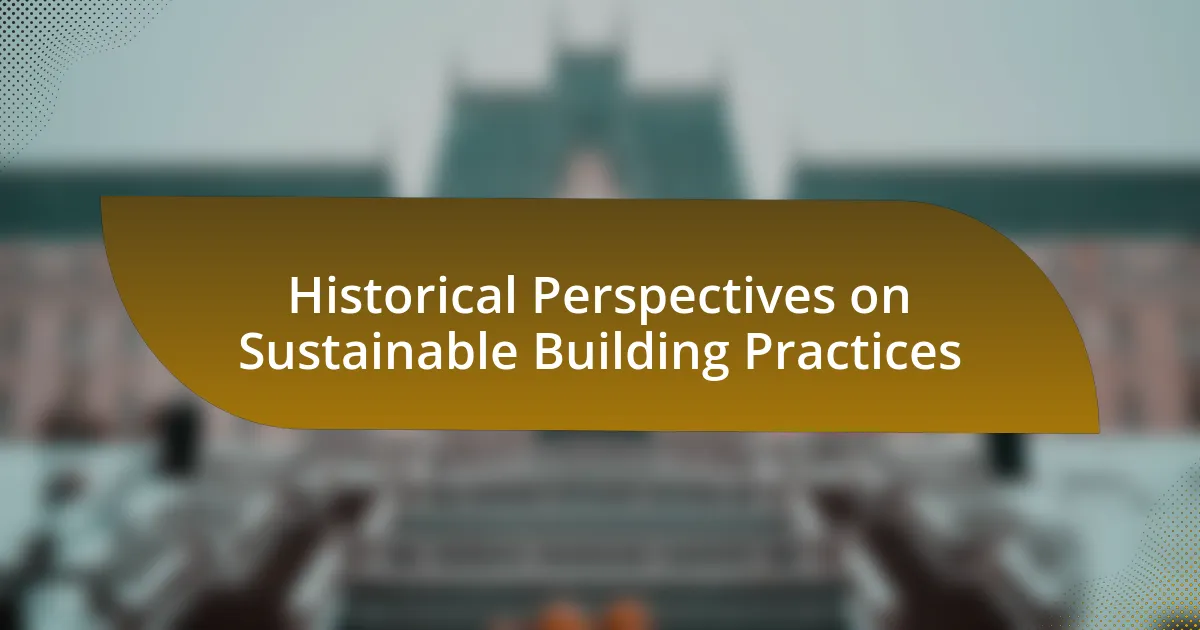The article examines historical perspectives on sustainable building practices, highlighting how ancient civilizations prioritized resource efficiency and environmental harmony through the use of local materials and climate-responsive designs. It traces the evolution of these practices from early techniques to modern innovations, including the impact of key historical events such as the Industrial Revolution and the environmental movement. The article also discusses notable examples of sustainable buildings, the lessons modern builders can learn from historical methods, and how these insights inform current sustainability standards and trends in construction. By analyzing past practices, the article emphasizes the importance of integrating ecological considerations into contemporary architecture.

What are Historical Perspectives on Sustainable Building Practices?
Historical perspectives on sustainable building practices reveal that ancient civilizations prioritized resource efficiency and environmental harmony. For instance, the use of local materials, such as adobe in the Southwest United States and bamboo in Asia, exemplifies early sustainable practices that minimized transportation costs and environmental impact. Additionally, the Roman aqueducts and the use of passive solar design in traditional Mediterranean architecture demonstrate an understanding of climate-responsive design long before modern sustainability concepts emerged. These historical practices laid the groundwork for contemporary sustainable architecture, emphasizing the importance of integrating ecological considerations into building design.
How have sustainable building practices evolved over time?
Sustainable building practices have evolved significantly from ancient techniques to modern innovations. Initially, ancient civilizations utilized local materials and passive solar design, as seen in the adobe structures of the Southwest United States and the stone buildings of ancient Greece, which maximized natural light and ventilation. In the 20th century, the rise of industrialization led to a focus on energy efficiency and the introduction of modern materials, such as reinforced concrete and steel, which allowed for more complex designs but often at the expense of sustainability.
The 1970s energy crisis prompted a renewed interest in sustainability, leading to the development of green building standards, such as LEED (Leadership in Energy and Environmental Design), established in 1998, which set benchmarks for energy efficiency and environmental impact. Recent advancements include the integration of smart technology and renewable energy sources, such as solar panels and green roofs, which further enhance the sustainability of buildings. This evolution reflects a growing awareness of environmental issues and the need for sustainable development in the construction industry.
What key historical events influenced sustainable building practices?
Key historical events that influenced sustainable building practices include the Industrial Revolution, which led to increased urbanization and a subsequent awareness of environmental impacts, and the publication of the Brundtland Report in 1987, which popularized the concept of sustainable development. The Industrial Revolution, occurring from the late 18th to the early 19th century, marked a shift towards mass production and consumption, prompting early environmental movements to advocate for more sustainable practices. The Brundtland Report, officially titled “Our Common Future,” emphasized the need for sustainable development that meets present needs without compromising future generations, thus shaping policies and practices in architecture and construction. These events laid the groundwork for modern sustainable building practices by highlighting the importance of environmental stewardship and resource efficiency.
How did ancient civilizations approach sustainability in construction?
Ancient civilizations approached sustainability in construction by utilizing locally sourced materials and implementing techniques that minimized environmental impact. For instance, the Romans used volcanic ash in concrete, which enhanced durability and reduced the need for frequent repairs, while the Egyptians employed mud bricks made from local clay, which were energy-efficient to produce. Additionally, many ancient societies designed buildings to maximize natural light and ventilation, reducing reliance on artificial heating and cooling. These practices demonstrate a deep understanding of resource management and environmental stewardship, as evidenced by the longevity of structures like the Pantheon and the Pyramids, which have stood for millennia due to their sustainable construction methods.
Why is it important to study historical perspectives on sustainable building?
Studying historical perspectives on sustainable building is important because it provides insights into effective practices and lessons learned from past construction methods. Historical examples, such as the use of natural materials and passive solar design in ancient civilizations, demonstrate how sustainable principles were integrated long before modern terminology emerged. For instance, the use of adobe in the Southwest United States showcases how local materials can create energy-efficient structures, reducing environmental impact. Understanding these historical practices informs contemporary sustainable building strategies, allowing for the adaptation of successful techniques to modern contexts.
What lessons can modern builders learn from historical practices?
Modern builders can learn the importance of sustainability and resource efficiency from historical practices. For instance, ancient civilizations, such as the Romans, utilized local materials like stone and clay, which minimized transportation costs and environmental impact. Additionally, traditional building techniques, such as passive solar design used in ancient Greek architecture, optimized natural light and ventilation, reducing reliance on artificial heating and cooling systems. These historical methods demonstrate that integrating local resources and energy-efficient designs can lead to more sustainable construction practices today.
How do historical practices inform current sustainability standards?
Historical practices inform current sustainability standards by providing foundational knowledge and techniques that promote resource efficiency and environmental stewardship. For instance, ancient civilizations utilized local materials and passive solar design, which are now recognized as key principles in sustainable architecture. The use of adobe in the Southwest United States and rammed earth in various cultures exemplifies how traditional building methods minimize energy consumption and environmental impact. These historical practices demonstrate the effectiveness of sustainable methods, influencing modern standards that prioritize ecological balance and resource conservation.

What are the major milestones in the history of sustainable building practices?
The major milestones in the history of sustainable building practices include the establishment of the first green building rating system, the introduction of energy-efficient building codes, and the adoption of renewable energy technologies in construction. The U.S. Green Building Council launched the Leadership in Energy and Environmental Design (LEED) certification in 1998, which set a benchmark for sustainable building practices. In 2006, the International Energy Conservation Code (IECC) was introduced, mandating energy efficiency in new buildings. Additionally, the integration of solar panels and other renewable energy sources into building designs has gained momentum since the early 2000s, significantly reducing the carbon footprint of buildings. These milestones collectively represent significant advancements in promoting sustainability in the built environment.
What innovations have shaped sustainable building throughout history?
Innovations that have shaped sustainable building throughout history include the development of passive solar design, green roofs, and the use of sustainable materials. Passive solar design, which dates back to ancient civilizations, optimizes natural light and heat, reducing energy consumption. Green roofs, popularized in the 20th century, provide insulation, reduce stormwater runoff, and enhance biodiversity. The use of sustainable materials, such as bamboo and recycled steel, has gained traction since the late 20th century, promoting resource efficiency and reducing environmental impact. These innovations collectively contribute to energy efficiency, environmental conservation, and improved occupant health in buildings.
How did the Industrial Revolution impact sustainable building practices?
The Industrial Revolution significantly influenced sustainable building practices by introducing new materials and construction techniques that improved efficiency and reduced resource consumption. The widespread use of iron and later steel allowed for stronger, more durable structures, which minimized the need for frequent repairs and replacements. Additionally, the era saw the development of prefabrication methods, which streamlined construction processes and reduced waste. Historical evidence indicates that these advancements led to more energy-efficient buildings, as seen in the adoption of larger windows for natural light and ventilation, reducing reliance on artificial lighting and heating. Overall, the Industrial Revolution laid the groundwork for modern sustainable building practices by emphasizing efficiency and resource management.
What role did the environmental movement play in shaping modern practices?
The environmental movement significantly influenced modern practices by advocating for sustainability and ecological awareness in various sectors, including construction. This movement, which gained momentum in the 1960s and 1970s, led to the establishment of regulations and standards aimed at reducing environmental impact, such as the National Environmental Policy Act of 1969 in the United States. These regulations prompted the adoption of sustainable building practices, including energy-efficient designs, the use of renewable materials, and waste reduction strategies. The shift towards green architecture and LEED certification reflects the movement’s impact, as it encourages builders to prioritize environmental considerations in their projects.
What are some notable examples of sustainable buildings from history?
Notable examples of sustainable buildings from history include the ancient Roman aqueducts, which utilized gravity for water transport, minimizing energy use. Additionally, the Pueblo cliff dwellings in the American Southwest were constructed using adobe, a natural material that provided thermal mass and insulation, reducing energy consumption for heating and cooling. The use of local materials and passive solar design in these structures exemplifies early sustainable practices. Furthermore, the Hanging Gardens of Babylon, although debated in existence, are often cited for their innovative irrigation techniques that showcased an understanding of sustainable agriculture and water management. These historical examples illustrate the long-standing human endeavor to create environmentally conscious architecture.
Which ancient structures exemplify sustainable building techniques?
The ancient structures that exemplify sustainable building techniques include the Roman aqueducts, the Great Wall of China, and the adobe structures of the Pueblo peoples. Roman aqueducts utilized gravity to transport water over long distances, minimizing energy use and maximizing resource efficiency. The Great Wall of China, constructed with local materials such as earth and stone, demonstrates the use of available resources to create durable infrastructure. Additionally, the Pueblo peoples built adobe homes using sun-dried mud bricks, which provided natural insulation and utilized local materials, showcasing an understanding of environmental adaptation and energy efficiency. These examples highlight the integration of sustainable practices in ancient architecture, reflecting a deep awareness of resource management and environmental impact.
How have modern architects integrated historical sustainable practices into their designs?
Modern architects have integrated historical sustainable practices into their designs by adopting techniques such as passive solar heating, natural ventilation, and the use of local materials. For instance, many contemporary buildings utilize the principles of vernacular architecture, which historically emphasized climate-responsive design, to enhance energy efficiency. This approach is evident in the use of thick walls and strategically placed windows that maximize natural light and reduce reliance on artificial heating and cooling systems. Additionally, architects often reference traditional building methods, such as adobe construction or timber framing, which have proven durability and sustainability over centuries. These practices not only reduce environmental impact but also promote cultural heritage, as seen in projects that blend modern aesthetics with traditional craftsmanship.

How do historical perspectives influence contemporary sustainable building practices?
Historical perspectives significantly influence contemporary sustainable building practices by providing foundational knowledge and techniques that prioritize environmental stewardship. For instance, ancient civilizations, such as the Romans and Greeks, utilized local materials and passive solar design, which are principles still relevant in today’s sustainable architecture. The use of natural ventilation and thermal mass in historical buildings demonstrates effective energy management, informing modern strategies aimed at reducing carbon footprints. Furthermore, the revival of traditional building methods, such as cob and straw bale construction, reflects a growing recognition of the sustainability inherent in historical practices. This integration of past wisdom into current methodologies not only enhances ecological responsibility but also fosters a cultural continuity that values heritage in the context of modern sustainability efforts.
What current trends in sustainable building are rooted in historical practices?
Current trends in sustainable building, such as the use of natural materials, passive solar design, and water conservation techniques, are deeply rooted in historical practices. For instance, ancient civilizations utilized local materials like clay and stone, which minimized transportation emissions and environmental impact. Additionally, passive solar design, evident in traditional architecture, harnesses sunlight for heating and cooling, reducing reliance on artificial energy sources. Historical water conservation methods, such as rainwater harvesting used by indigenous cultures, are now being integrated into modern sustainable practices to address water scarcity. These examples illustrate how contemporary sustainable building trends draw inspiration from time-tested methods that prioritize environmental stewardship and resource efficiency.
How are traditional materials being revived in modern construction?
Traditional materials are being revived in modern construction through a focus on sustainability and cultural heritage. Architects and builders are increasingly incorporating materials such as rammed earth, straw bale, and timber, which have been used for centuries, to reduce environmental impact and enhance energy efficiency. For instance, the use of rammed earth not only provides excellent thermal mass but also utilizes locally sourced materials, minimizing transportation emissions. Additionally, the resurgence of timber framing aligns with contemporary sustainability goals, as timber is a renewable resource that sequesters carbon. This revival is supported by a growing body of research highlighting the benefits of traditional materials in reducing the carbon footprint of buildings, as seen in studies from institutions like the University of Cambridge, which emphasize the ecological advantages of using locally sourced, traditional materials in construction.
What historical design principles are being reinterpreted today?
Historical design principles such as biophilic design, passive solar heating, and vernacular architecture are being reinterpreted today. Biophilic design emphasizes the connection between humans and nature, drawing from historical practices that integrated natural elements into built environments to enhance well-being. Passive solar heating, rooted in ancient architectural techniques, utilizes sunlight for energy efficiency, reflecting a growing emphasis on sustainability in modern design. Vernacular architecture, which adapts to local climates and materials, is being revisited to promote environmentally responsive building practices. These principles are increasingly relevant as contemporary architects seek to create sustainable, energy-efficient structures that honor historical wisdom while addressing current environmental challenges.
How can understanding historical perspectives enhance future sustainable practices?
Understanding historical perspectives enhances future sustainable practices by providing insights into past successes and failures in resource management and environmental stewardship. Historical examples, such as the use of local materials in ancient architecture, demonstrate how communities adapted to their environments sustainably. For instance, the Pueblo peoples of the American Southwest utilized adobe construction, which effectively regulated temperature and minimized energy use, showcasing a long-standing commitment to sustainability. By analyzing these practices, modern builders can adopt similar strategies that prioritize ecological balance and resource efficiency, ultimately leading to more sustainable development.
What strategies can builders adopt from historical practices to improve sustainability?
Builders can adopt strategies such as using local materials, implementing passive solar design, and incorporating traditional building techniques to improve sustainability. Historical practices often emphasized the use of locally sourced materials, which reduces transportation emissions and supports local economies. For instance, indigenous communities utilized materials like adobe and timber, which were abundant in their regions, leading to lower environmental impact.
Additionally, passive solar design, which involves orienting buildings to maximize natural light and heat, has been a practice since ancient times, as seen in Roman and Greek architecture. This approach minimizes reliance on artificial heating and cooling systems, thus conserving energy.
Furthermore, traditional techniques such as thatching and rammed earth construction have proven effective in regulating indoor temperatures and reducing energy consumption. These methods not only enhance sustainability but also promote resilience against climate change by utilizing natural resources efficiently.
How can historical case studies inform policy-making in sustainable construction?
Historical case studies can inform policy-making in sustainable construction by providing empirical evidence of successful practices and their outcomes. For instance, the use of rammed earth construction in ancient China demonstrates durability and thermal efficiency, which can guide modern policies towards low-carbon materials. Additionally, the implementation of passive solar design in historical buildings, such as those in Mediterranean regions, showcases energy efficiency strategies that can be integrated into contemporary building codes. These examples illustrate how analyzing past successes and failures can lead to informed decisions that promote sustainability in current construction policies.
What practical tips can be derived from historical perspectives on sustainable building?
Practical tips derived from historical perspectives on sustainable building include utilizing local materials, designing for climate, and incorporating passive solar techniques. Historical examples, such as the use of adobe in arid regions, demonstrate the effectiveness of local materials in reducing transportation emissions and enhancing thermal performance. Additionally, traditional designs often reflect an understanding of local climate conditions, as seen in the orientation of buildings to maximize natural light and ventilation, which reduces reliance on artificial heating and cooling. Furthermore, ancient structures like the Roman aqueducts illustrate the importance of water management systems, emphasizing the need for sustainable water use in modern building practices. These historical insights provide a foundation for contemporary sustainable architecture by highlighting the benefits of resource efficiency and environmental harmony.
